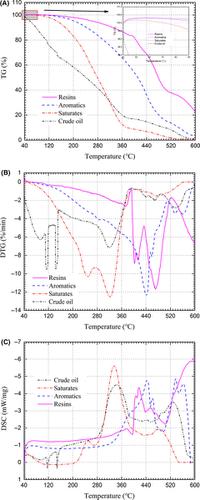当前位置:
X-MOL 学术
›
Energy Sci. Eng.
›
论文详情
Our official English website, www.x-mol.net, welcomes your
feedback! (Note: you will need to create a separate account there.)
Quantification of low‐temperature oxidation of light oil and its SAR fractions with TG‐DSC and TG‐FTIR analysis
Energy Science & Engineering ( IF 3.5 ) Pub Date : 2019-12-25 , DOI: 10.1002/ese3.506 Tengfei Wang 1, 2 , Jiexiang Wang 1 , Weipeng Yang 3 , Daoyong Yang 2
Energy Science & Engineering ( IF 3.5 ) Pub Date : 2019-12-25 , DOI: 10.1002/ese3.506 Tengfei Wang 1, 2 , Jiexiang Wang 1 , Weipeng Yang 3 , Daoyong Yang 2
Affiliation

|
The oxidation reaction is the key to determining the success of air flooding. In this paper, experimental and theoretical techniques have been developed to identify the low‐temperature oxidation (LTO) mechanisms for light oil during air flooding by comprehensively analyzing thermal stability and oxidation process of the crude oil and its SAR (ie, saturates, aromatics, and resins) fractions. Experimentally, both a thermogravimetric analyzer coupled with differential scanning calorimetry (TG‐DSC) and a thermogravimetric analyzer coupled with Fourier transform infrared spectrometer (TG‐FTIR) are employed to quantify the LTO process of crude oil and each SAR fraction as well as the corresponding oxidation properties. Theoretically, reaction models have been developed to reproduce the experimentally identified reactions. The results show that the oxygen addition reaction and the bond scission reaction occur simultaneously. The former can be initiated when temperature is higher than 50°C, and it is gradually shifted to the latter with the continuous increase in reservoir temperature. The LTO products of light oil include H2O, CO2, carboxylic acids, alcohols, phenols, and ethers. Saturates, aromatics, and resins are all the sources of H2O, CO2, alcohols, and carboxylic acids, whereas ethers are mainly derived from aromatics and resins. At the beginning of an air flooding process, heat is mainly generated from the oxidation of aromatics and resins. Subsequently, oxidizing saturates gradually dominates the air flooding process with an increase in the reservoir temperature.
中文翻译:

用TG-DSC和TG-FTIR分析定量分析轻油及其SAR馏分的低温氧化
氧化反应是确定驱油成功与否的关键。本文通过开发实验和理论技术,通过全面分析原油及其SAR(即饱和油,芳烃,和树脂)馏分。在实验上,结合差示扫描量热法(TG-DSC)的热重分析仪和与傅立叶变换红外光谱仪(TG-FTIR)结合的热重分析仪均用于量化原油和每个SAR馏分以及相应的SAR的LTO过程。氧化性能。从理论上讲,已经开发了反应模型来重现实验确定的反应。结果表明,氧加成反应和键断裂反应同时发生。前者可以在温度高于50°C时启动,随着储层温度的不断升高,它会逐渐转移到后者。轻油的LTO产品包括H2 O,CO 2,羧酸,醇,酚和醚。饱和物,芳族化合物和树脂都是H 2 O,CO 2,醇和羧酸的来源,而醚主要来自芳族化合物和树脂。在驱气过程开始时,热量主要是由芳族化合物和树脂的氧化产生的。随后,随着储层温度的升高,饱和的氧化作用逐渐主导了驱油过程。
更新日期:2019-12-25
中文翻译:

用TG-DSC和TG-FTIR分析定量分析轻油及其SAR馏分的低温氧化
氧化反应是确定驱油成功与否的关键。本文通过开发实验和理论技术,通过全面分析原油及其SAR(即饱和油,芳烃,和树脂)馏分。在实验上,结合差示扫描量热法(TG-DSC)的热重分析仪和与傅立叶变换红外光谱仪(TG-FTIR)结合的热重分析仪均用于量化原油和每个SAR馏分以及相应的SAR的LTO过程。氧化性能。从理论上讲,已经开发了反应模型来重现实验确定的反应。结果表明,氧加成反应和键断裂反应同时发生。前者可以在温度高于50°C时启动,随着储层温度的不断升高,它会逐渐转移到后者。轻油的LTO产品包括H2 O,CO 2,羧酸,醇,酚和醚。饱和物,芳族化合物和树脂都是H 2 O,CO 2,醇和羧酸的来源,而醚主要来自芳族化合物和树脂。在驱气过程开始时,热量主要是由芳族化合物和树脂的氧化产生的。随后,随着储层温度的升高,饱和的氧化作用逐渐主导了驱油过程。









































 京公网安备 11010802027423号
京公网安备 11010802027423号